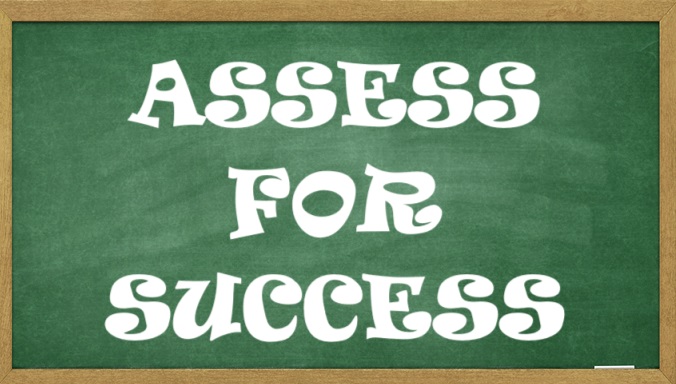
For college bound high school students, there are 7 major challenges:
- Most assessments assess for disabilities. At 3D Learner, we Assess for Success.
- Their present level of performance is not consistent to getting into the college of their choice
- Their reading comprehension level and vocabulary are not yet consistent with what they need it to be to, either get into the college of their choice or to qualify for scholarships.
- Reading speed is often an issue.
- Math word problems often cause issues, especially on the SAT and ACT tests.
- Attention, working memory and/or processing speed may be a challenge.
- For older students, it is important for them to see the value in how we Assess for Success.
For these students, we use a two-pronged assessment:
- The Mindprint Assessment that allows us to identify:
- Executive function strengths and challenges
- Their projected SAT and ACT scores
- What their potential SAT and ACT scores are
- The Reading Plus Assessment ® that shows the student’s:
- Reading Comprehension Level
- Reading Speed
- Vocabulary level

With this information and the student’s and parent’s goals, we can then formulate options.
For the student who is really struggling, we add the Structure of Intellect Assessment ® that shows:
- How your child learns best
- Where they are strong and where they struggle
- Whether there appears to be a visual or auditory processing issues

With this information and the student’s and parent’s goals, we can then formulate options
To discuss the possibilities for improving reading comprehension, SAT and other skills, you can either:

(Click here for 7 Tips on How to Improve Reading Comprehension and Speed for Your Child)
Reading comprehension is a major issue for many 4th to 12th graders.
- We have assessed many students whose reading comprehension is 2, 3, 4 and even 5 years below grade level
- Too often their reading speed is so slow, that it is tortuous for them to read
- The good news is that with the right help, reading comprehension can be improved by 2, 3 and even 4 grade levels within months. Their reading speed can often be improved by 50 to 100%.
For too many smart and even gifted students, their reading comprehension is often at grade level, but two to three years below their peers. Their reading speed is often slow. The good news is that:
- Their reading comprehension can often be improved by 2 or 3 grade levels within 6 months
- Their reading speed can be improved by 50 or 100%
- This can dramatically improve their:
- Grade point average
- SAT and/or ACT scores
- Chances of getting into the college of their choice
These students are often either right brain neurodivergent learners and/or they have a visual processing issue. Many assessments miss these items or do not leverage a student’s ability to learn best when they see and experience information and/or miss a visual processing issue.
We strongly recommend sitting down with your child and completing these two screening tools.
Click here to see if your child is a right-brain neurodivergent learner.
Click here to see if your child has a visual processing issue.
Your child’s answers may surprise you and allow you to leverage the insights you become aware of.
Below are the 7 Tips on How to Improve Reading Comprehension and Reading Speed for your child.
Why and How to Improve Reading Speed and Reading Comprehension for 4th to 12th Graders
- Find out what your child’s present level of reading speed and reading comprehension are and what is their present Grade Point Average and SAT scores, if appropriate
- How would it change your child’s life if they improved their reading comprehension by 2, 3 or even 4 grade levels over the next 6 months? How would it help your child if they improved their reading speed by 50 to 100%? How would it effect:
- The classes they are in and their grade point average
- Their performance on standardized tests
- Homework time and stress
- Prospects for getting into the college or university of their choice
- Chances of getting a $20,000 or $30,000 scholarship
- Have a positive, open conversation with your child about how they feel. Listen to their fears, their ideas of what they want and what they like. Give positive support and together make a list of ideas that they want help on. As you work on this list – take note of what strategies work and what doesn’t work. Make as many activities hands-on or active as possible.
Note, discuss this with your child and if appropriate, create a WHY Document, why you want this and why your child wants it.
4. Strongly consider getting an outside evaluation that assesses for:
-
- How your child learns best.
- Their strengths and challenges
- Their present level of reading speed and reading comprehension
The two most common items that are missed are:
a- If your child is a right-brain neurodivergent learner who learns best when they see and experience information.
b- Does your child have a visual processing issue, where they skip words and lines when reading, process information slowly and make too many stupid mistakes in math tests,
We recommend sitting down with your child and completing these two screening tools:
Click here to see if your child is a right-brain neurodivergent learner.
Click here to see if your child has a visual processing issue.
- Set BOLD Goals for your child. Let’s say your child is presently 2 years behind in reading comprehension. Consider a goal to get your child back to grade level within months. We recommend including a non-academic goal in an area of interest to your child. This might be in sports, music, martial arts or another area of interest to your child.
6– Follow through for maximum results.
7- Being consistent is key! These kids need structure and a visual schedule to follow.
3D Learner can help with all 7 steps.

Reading comprehension, reading speed and/or math, especially algebra, are major issues for many students in grades 7 to 12.
If you have a child who is a lot smarter than present results would indicate, the three keys to your child’s success are to recognize that:
- You want to reject the status quo.
- Recognize there is an opportunity to:
- Increase your child’s reading comprehension – often by 2, 3 or even 4 grade levels in 6 months
- Understand that math is much more dependent on understanding the question than it was in our time. Many students who are getting Cs, Ds and Fs are capable of getting As and Bs
- Reading speed and visual processing issues are often related. If there is a visual processing issue it is important to address. If there is a reading speed issue it is often possible to increase your child’s reading speed by 50 to 100%, while increasing reading comprehension by 2, 3 or even 4 grade levels
- As a parent, your role in rejecting the status quo, recognizing the opportunity and in partnering with the right professionals is mission critical
If you would like to have a conversation on these or other matters,
call us at 561-361-7495.
Reading Comprehension and Math Problems Impact Most of Our Students
We were surprised when we learned about a longitudinal study that showed that over 60 percent of the students with disabilities in middle and high school were 3 or more years below grade level in their reading comprehension and math, and many were further behind. This happens to many kids, even from the best families.
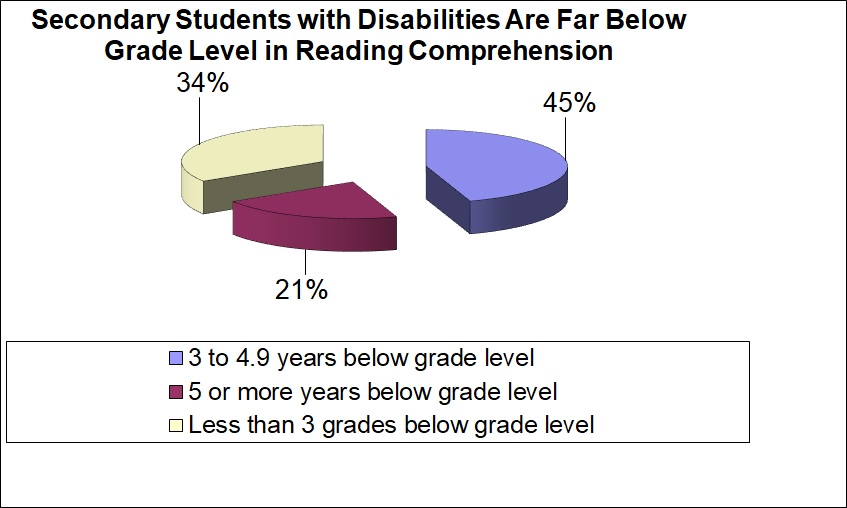
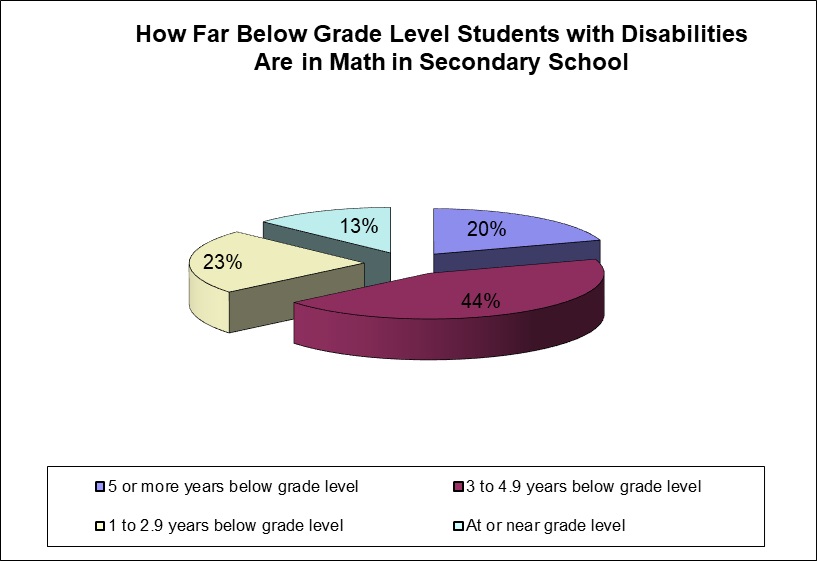
What is even more surprising is how many smart and even gifted students:
- Have reading comprehension levels well below what you would expect
- Read slowly – sometimes as slow as 100 words per minute
- Struggle with math problems, and really struggle on the SAT and ACT tests
‘The good news is that with the right program these students, with the right help, can often:
- Improve their reading comprehension 2, 3 and even 4 grade levels within 6 months
- Increase their reading speed by 50% and 100%
- Improve their math grades from Cs. Ds and Fs to As and Bs
- Significantly improve their SAT and ACT scores and their GPAs
The three keys to their success are:
- Parents choosing to make the difference
- Finding the right professionals who teach the way your child learns best, will identify and address their challenges and know how to engage and motivate your child
- Getting your child to want to succeed. With teenagers, they need to want it. At 3D Learner, we often play a part in motivating the student
Get It Right – 3 Examples of How Parents Made The Difference
Nate was struggling with grades, reading comprehension and his reading speed was an issue. The parents certainly wanted to Get It Right. The challenge was how to get him interested in improving. We had that conversation and he realized if he improved his reading speed and reading comprehension, it would improve his grades and give him more time for what he loved to do. In 4 months, he was able to improve his reading comprehension 4 grade levels, increase his reading speed by 80% (i.e. from 200 to 360 words per minute) and he had more time to work on his art projects. Later, he earned a full scholarship to college.
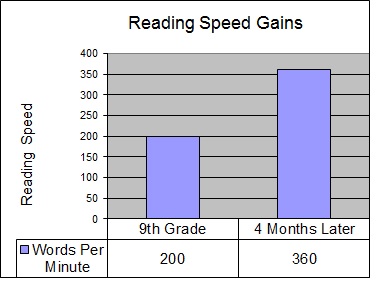

Eric was a 7th grader who was having behavior challenges, his reading was 4 years below grade level and his batting average was now below 300. His parents rejected the status quo and wanted help, but Eric was a reluctant student. We shifted the conversation to improving his baseball average from 290 to 350 and his home runs from 1 to 5. He was excited. With our help, he improved his reading comprehension by 4 grade levels, and was now doing well in regular classes. He was delighted to see his batting average go from 290 to 405 and his homerun production from 1 to 9.
The 3D Learner Origin Story
Our daughter faced a real challenge with her reading comprehension being 3 years below grade level and her grade point average at 2.7 well below her potential. When we were told she was not college material, because of her reading comprehension, her mother, Mira Halpert, became a Mom on a Mission”. Mira, who has her Masters in Education from the University of Michigan, discovered our daughter was a right brain learner – who learned best when she saw and experienced information, Mira developed what became known as the 3D Learner Program that helped our daughter to:
- Improve her reading comprehension 4.2 grade levels in 7 months
- Increase her Grade Point Average from a 2.7 to a 4.4
- Later earn her doctorate in education

The 3D Learner Difference — A Strength Based Focus
The first key difference in what we do is to leverage a student’s strengths and interests. They are often right brain learners — who learn best when they see and experience information. They often, but not always have executive function and/or visual processing issues. Dyslexia is present in a number of cases.
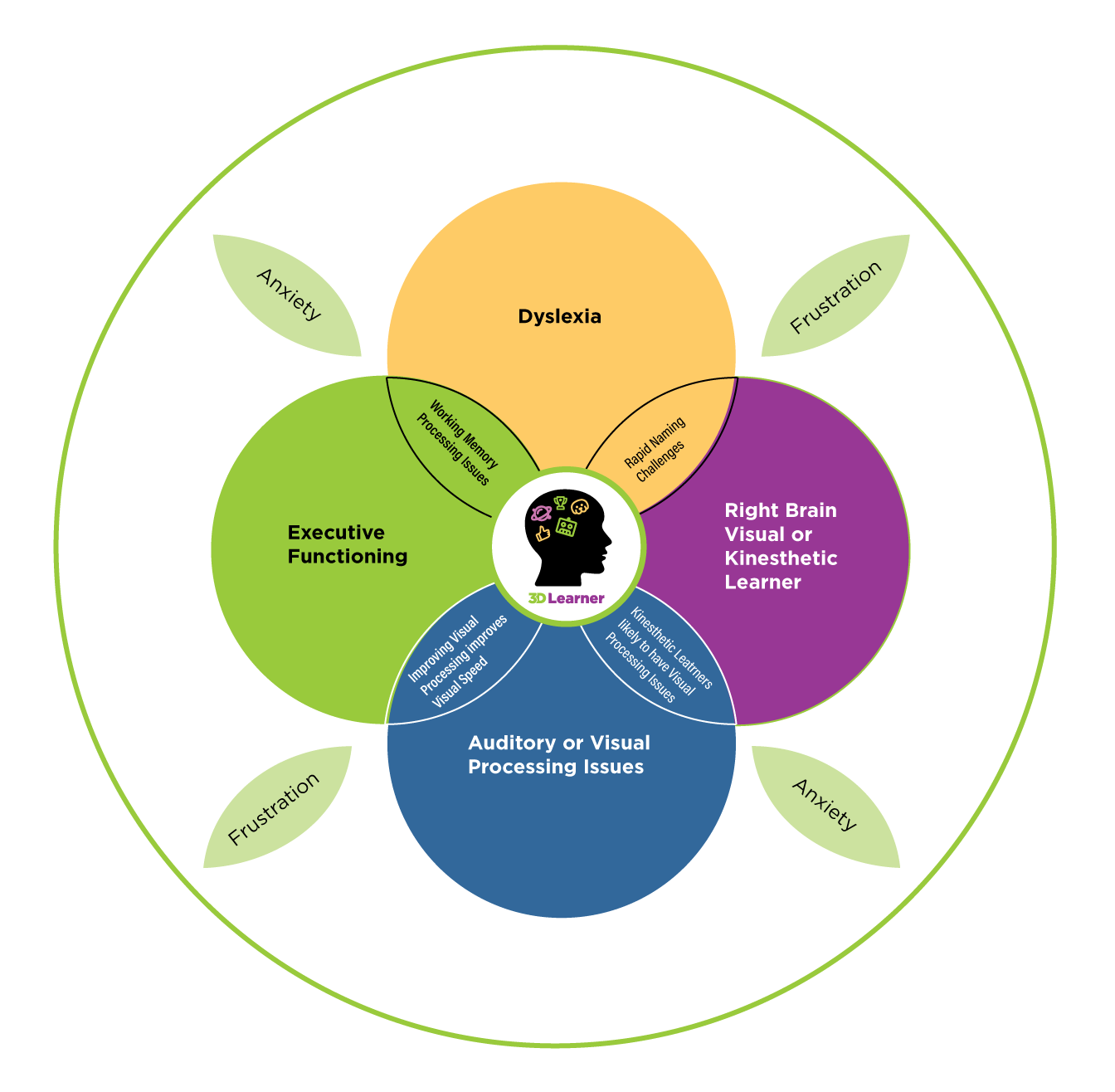 3D Learner focuses first and foremost on our student’s strengths and interests, and we do identify and address their challenges, while boosting their confidence.
3D Learner focuses first and foremost on our student’s strengths and interests, and we do identify and address their challenges, while boosting their confidence.
If your child is struggling with reading comprehension, reading speed and/or math, and you want to explore how your child can be far more successful,

Transformational Strength Based Parenting can make the difference for your child this school year.
Comments parents have shared with us:
“My 4th grade child’s reading speed is so slow it makes reading comprehension very difficult”
“My child’s reading comprehension is at the 1st grade level as she enters 5th grade, despite our investing $34000 in a program”.
“My 6th grade child is at the 48th percentile in reading comprehension. I asked her principal what I can do and he said “nothing was needed, someone has to be average”
The good news is that each of these parents rejected the status quo and helped their child to make significant gains. This included:
- Improving reading speed by 80 percent, increasing reading comprehension by 3 grade levels, and identifying and addressing a visual processing issue that allowed the student to read without headaches
- Doubling a student’s reading speed, while improving reading comprehension by 4 grade levels
- Helping a student improve her reading comprehension from the 48th to the 95th percentile
None of these parents were willing to accept the status quo. This blog post is focused on:
- The risks facing present 4th, 5th and 6th graders and their parents
- The opportunities that exist to significantly improve reading fluency, reading speed and reading comprehension. This can improve confidence and self-esteem
- The pivotal role that you the parent can play to make the difference for your child
- Some resources that may be available to you in Florida that include:
- For public and charter school parents whose VPK to 5th grade child meets certain criteria, your child will qualify for a $1200 New Worlds Scholarship Accounts Program
- For private and homeschool parents, there are two opportunities that include:
Three important perspectives these parents had:
- They were unwilling to accept the status quo and they wanted a program that would yield transformational results that would improve reading fluency, reading speed and reading comprehension
- Once they realized their child learned differently and had a number of challenges, they wanted an integrated, engaging and effective program that would improve academics, self-esteem and confidence.
- They wanted help to be the coach and advocate their child needed
Note, at one point we were in this exact situation. The 3D Learner Program ® was developed for our own daughter, who was 3 years below grade level in 8th grade. “With the 3D Learner Program I developed our daughter was able to improve her reading comprehension 4.2 grade levels in 7 months and in August 2024 our daughter Julie earned her doctorate in education from the University of Florida.
The Risks are Real
Reading fluency, reading speed and/or comprehension are common issues for 4th, 5th and 6th graders. This is especially true in this post pandemic era, where your child was not in school during some critical years. 4 of the key risks students face include:
- Being a slow reader and continuing to avoid reading. Having their reading comprehension fall 3, 4, or even further below grade level. As the graph below shows, for students with a disability in middle and high school 45% were 3 to 4.9 years below grade level and an additional 21% were 5 or more years below grade level in their reading comprehension

- Homework will take more time and frustration often follows. Especially as math word problems become more complex and the reading becomes more complex, with less pictures.
- Standardized test scores continue to be low, and your child missed the fun electives as they are pulled out for additional reading help
- Self-esteem and confidence often decline
The Opportunities are Often Significant
- Reading fluency and reading speed can often be improved
- Significant comprehension gains can be made within months
- Homework time and stress can often be reduced by 25 to 50%, with your child becoming more independent
- Many students learn to love reading and their confidence and self-esteem increase
- With new tools to be an even more effective coach and advocate for your child, the stress decreases, you become an even more collaborative and effective advocate and raising your child becomes much more fun
The Pivotal Role of Transformational Strength Based Parenting
- Seeing if your child is a right brain neurodivergent child who learns best when he or she sees and experiences information — click here for a screening tool to see if your child is a right brain neurodivergent learner. Most smart struggling students are right brain neurodivergent learners.
- Identifying and addressing the challenges if your child has dyslexia, ADHD, Executive Function challenges, visual processing issues and/or anxiety challenges. Most of our students learn differently and have several of these issues
- Rejecting the status quo. This is a critical step on your child’s pathway to success
- Being committed to Transformational Strength Based Parenting and making a huge difference in your child’s life
- Finding the right professional help to make it happen
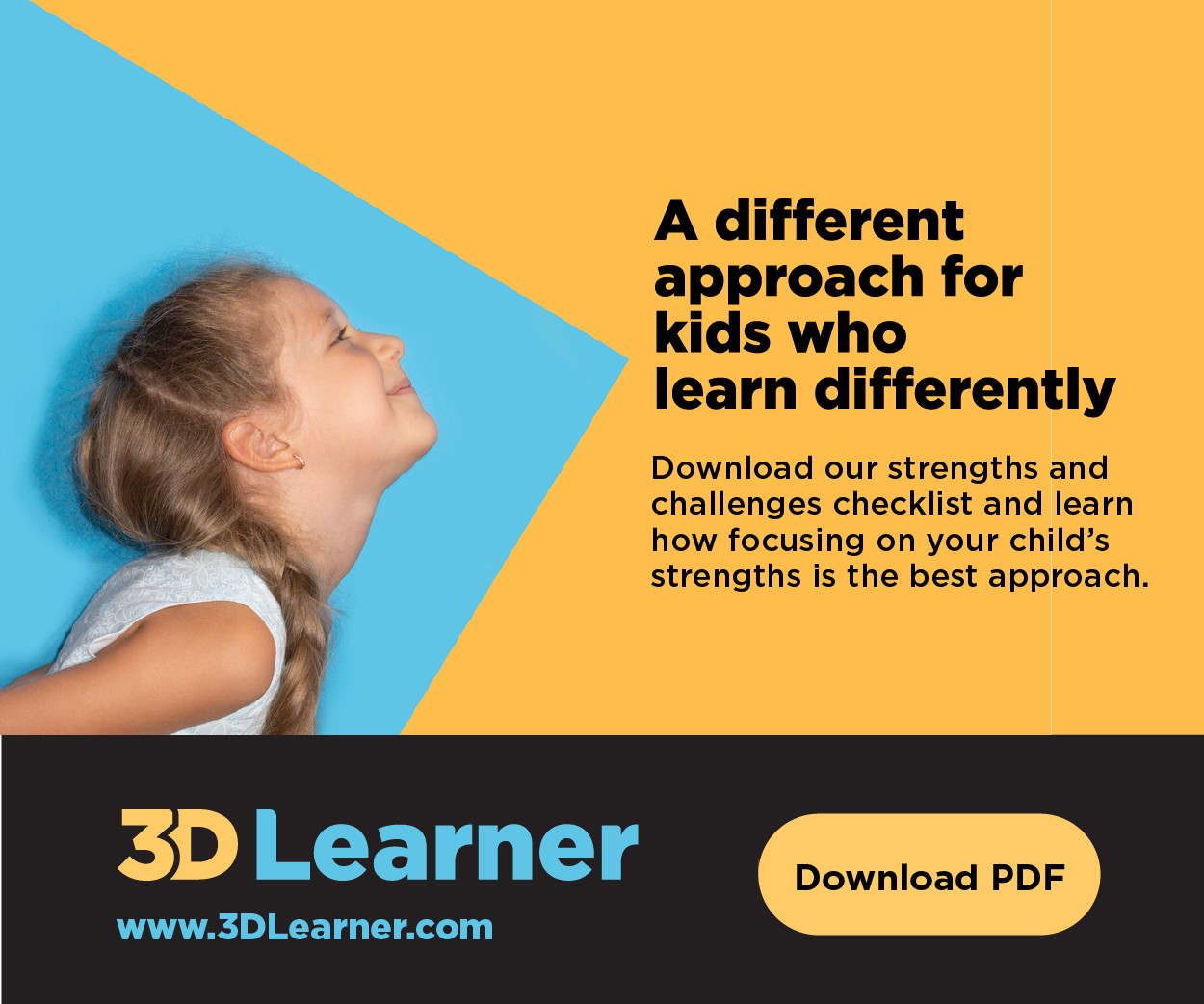
At 3D Learner, we want to better understand your challenges, offer advice on how you can help your child and if appropriate, share how we can help. If you would like a no cost conversation you can either call us at 561-361-7495 or click here to schedule a How Can I Help My 4th, 5th or 6th Grade Child conversation
3D Learner, Committed to Transformational
Strength Based Parenting
That Makes The Difference for Your Child and You
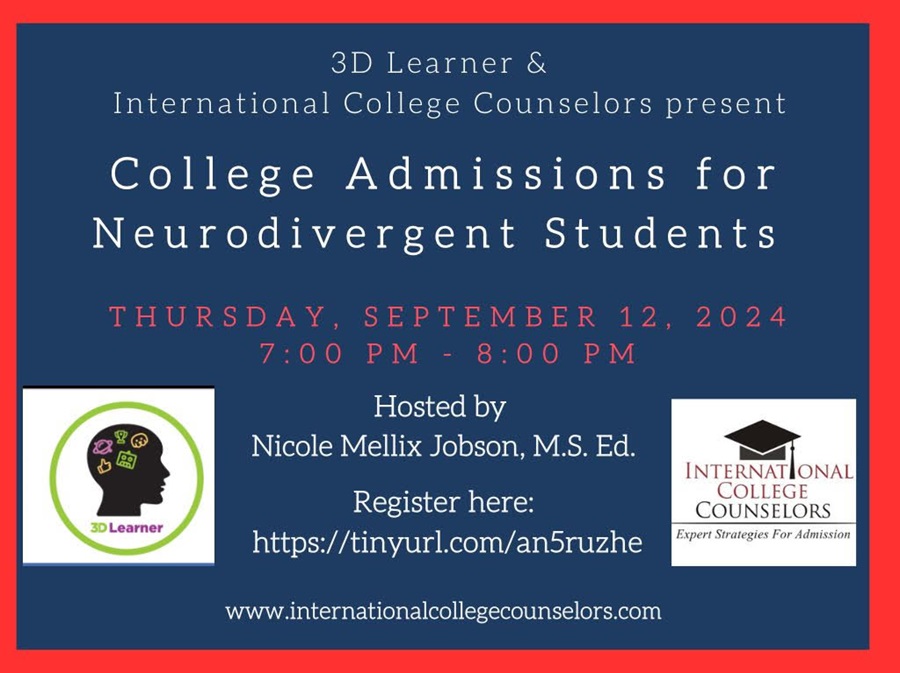
At 3D Learner, we address parents’ concern on how to improve SAT Scores. For years, we have worked with International College Counselors, a highly reputable and experienced company that has helped thousands of students to plan for and be admitted into the just right college or university.
On Thursday evening, September 12th, we will be part of a webinar hosted by Nicole Jobson, a longtime member of the International College Counselors team.
Nicole will:
- Provide college preparation, selection, and application strategies which address the unique needs of neurodivergent students.
- Offer insight on how to balance a competitive application process with compassion, while meeting the student’s specific needs.
- Ease the anxiety often faced by families during the college application process by equipping them with practical tools and resources specifically designed for neurodivergent applicants.
We will be addressing how to improve SAT scores, and how to improve reading comprehension and GPAs for:
- The bright right brain, neurodivergent learner who needs to improve their reading comprehension, attention and other issues to improve SAT scores. We define a right brain neurodivergent learner as one who learns best when they see and experience information.
- The motivated student who wants to know how to improve SAT scores to get into a better college and/or to earn a scholarship — like Florida’s Bright Futures Scholarship
- How increased SAT scores can help a student in Florida earn scholarships that may be worth $20,000 to $30,000
Help your child to get into a better college and to be far better prepared to succeed in college.
The Digital SAT was introduced in March 2024. The new Digital SAT was hard for all students. For right brain neurodivergent learners, the Digital SAT was even harder. While the new digital app worked well, there were several comments that were shared by a number of students we have spoken with:
- The math section of the Digital SAT was very hard, with a number of new and different types of questions.
- The reading section was different – with a number of new questions on punctuation, “dependent” and “independent“ clauses and many questions that required inference skills.
- Overall, the SAT scores were close to historical levels, since the test was curved to do that.
The bad news is that those who struggled with the new format did much worse.
A positive note is that once a student learns how to solve the problems, they can see significantly improved SAT scores. It’s about learning new skills, looking for the tricks and finding patterns!
We have been helping students improve SAT scores for many years. What we have found is that many students struggle and:
- Lose focus during the test
- Read slowly and have problems with vocabulary and reading comprehension
- Struggle with the SAT because the questions are tricky. It is not straight forward, so being able to understand multiple meaning words is vital
3D Learner has a unique approach, where we can help a student:
- Improve their attention. This helps them to score better and do better in school and athletics
- Increase their vocabulary, reading speed and reading comprehension
- Then work on improving reading and math SAT Scores
- Show the student even more effective ways to solve the problems
- Increase their test scores, often by a significant amount
Advice to All Parents
- If your child complained about the March 2024 or June Digital SAT test — listen and respect their frustration. As with any new test, change is hard.
- If you are using books from before 2024, get new books. The questions are quite different. We use two 2025 Princeton Review Books for the Digital SAT 2025. Here are the books and a link to Amazon for each one:
- Practice with the new questions can be very helpful. We recommend you consider:
- Working with a professional who has had experience with these tests
- Having your child practice more than normal
- Be prepared to have your child take the test more than once
- Set goals with your child. This is especially true for students who want to get into a top flight school or one who wants to earn a scholarship
For example, in Florida, a student needs a 1210 combined SAT to qualify for the Bright Futures Scholarship that might be worth $20,000 over 4 years, and a 1340 combined SAT score to earn a Bright Futures Scholarship that might be worth close to $30,000 over 4 years.
We had a rising senior who needed to get a 3.6 GPA and a 1210 on his SAT to qualify for the Bright Futures Scholarship. This was a challenge given his cumulative GPA was 2.8 and his initial SAT scores were 1010. With our help and the motivation provided by the scholarship, he got a 3.75 GPA and a 1220 on his SAT score. Motivation matters.
Have your child set goals, track their progress and reward their gains.
Advice to Parents to Improve SAT Scores and Get Into the Best College for Them
- Work with professionals whose expertise is helping kids like yours get into the best possible schools. International College Counselors helps both:
- Neurodivergent learners get into a school that meets their needs
- Neurotypical students get into top universities
- Do all of the above and consider working with someone who understands your child’s specific strengths and challenges and can help them succeed. These might include:
- We have a number of students who lose focus during the test, and this happens elsewhere. At 3D Learner, we use the Interactive Metronome ® to improve attention. It also:
- Improves reading fluency by one grade level
- Improves math fluency by two grade levels
- Improves sports and related skills
- Creates new neural pathways that appear to be permanent
- Improving vocabulary, reading speed and reading comprehension
- The wording is different, and it helps to have someone who can explain things in a hands-on visual approach, that will allow your child to understand the concept
- Reading speed is often a challenge for the right brain neurodivergent learner. We have been able to significantly increase a student’s reading speed, while also improving their reading comprehension
We had a student who read at 125 words per minute and could not complete the test. With training, he increased his reading speed to 300 words per minute, while improving his reading comprehension 2 grade levels. His reading SAT score increased by 140 points.
- Reading comprehension is an issue for two different groups:
- When reading comprehension is well below grade level, getting a good SAT score can be very difficult. When one improves reading comprehension by 2 or 3 grade levels, GPAs and SAT scores both improve
- When a student wants to get into a really competitive school, improving reading speed, reading comprehension and vocabulary combined with SAT Prep can result in a significant improvement in their SAT score
- Finding someone who can show them an even easier way to solve the problems and who share it in a way that your child will accept their advice
- Having someone who can explain the new grammar questions and how to address them
- Having the availability to schedule extra sessions to help your child adjust and master the necessary skills. All of this training is done remotely-
- Be flexible and consider having your child take the test more than once, with enough time in between to significantly improve their results
Due to the significant changes in the Digital SAT, we expect those students who get the right help and practice enough, to see even greater benefits than normally. For a right brain neurodivergent learner, the new Digital SAT presents both significant risks and opportunities.
If you would like to discuss your child’s unique situation and explore how to improve SAT scores, please
call us at 561-361-7495 in Florida or
at 919-371-5295 in North Carolina.
For personalized guidance on the college preparation, selection, and application process for your child, please contact Nicole Jobson, MS. Ed. at 954-414-9986 (office) or 954-288-4496 (cell).



![]()
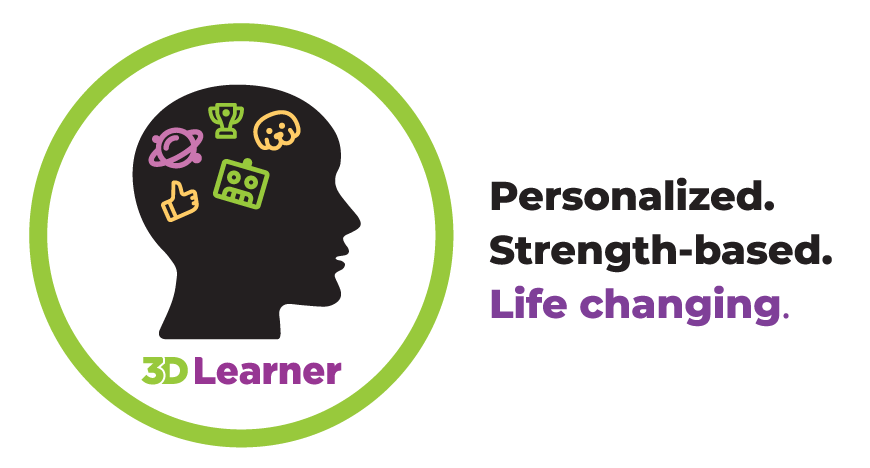
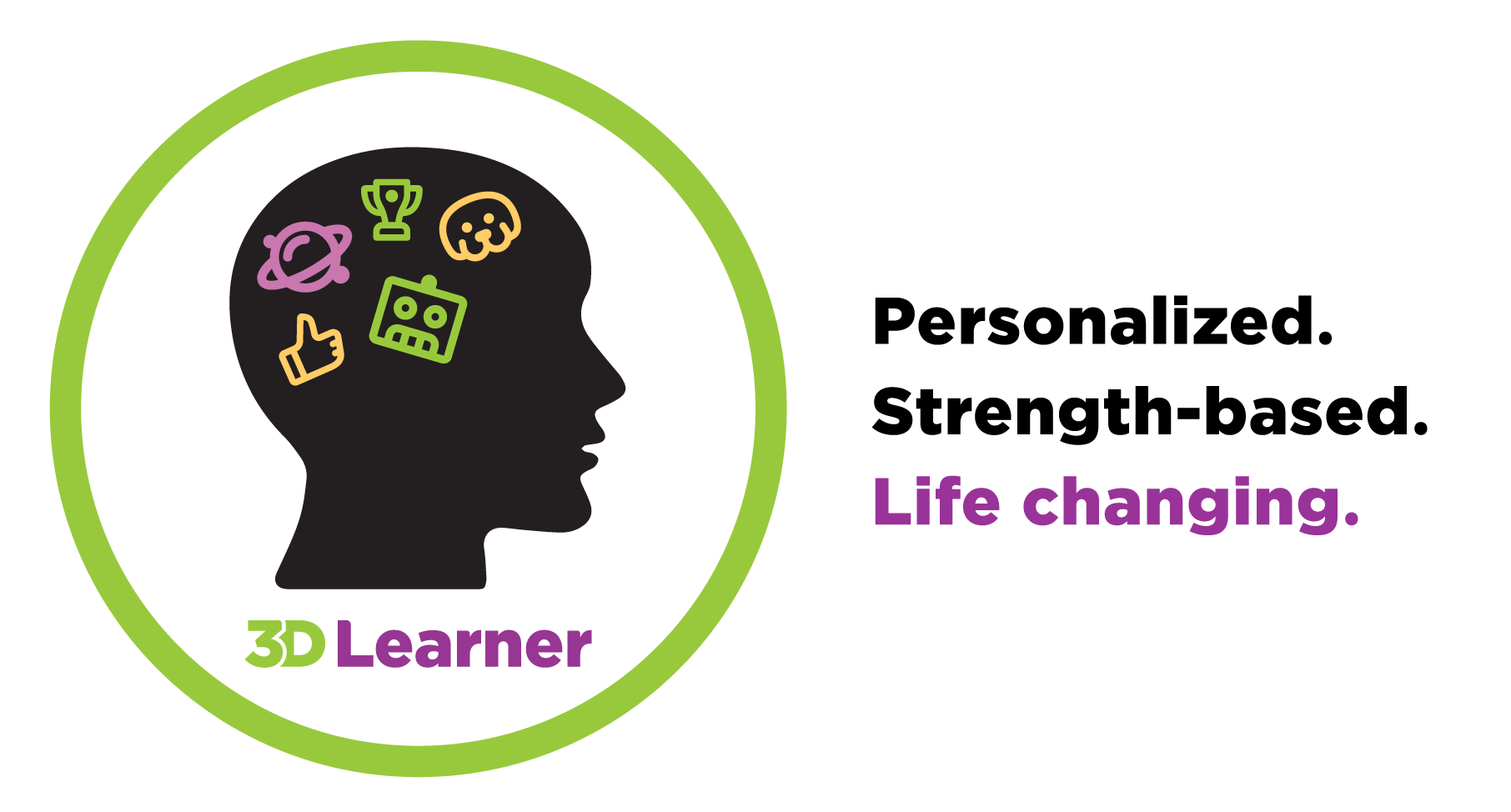










Recent Comments